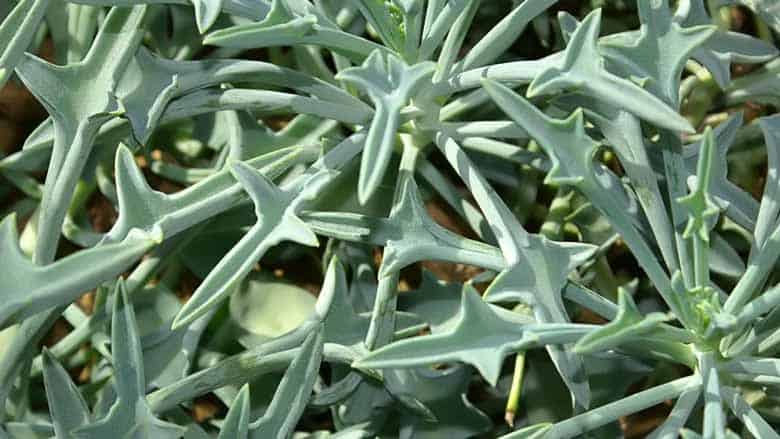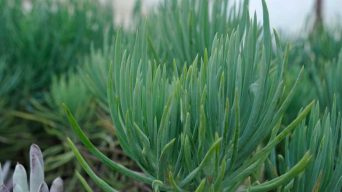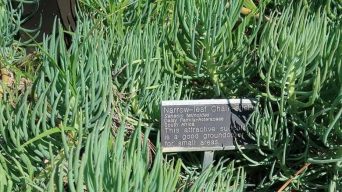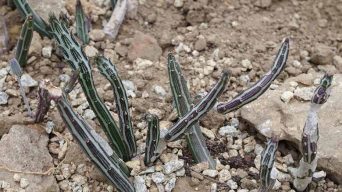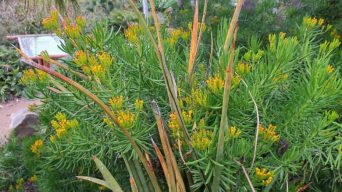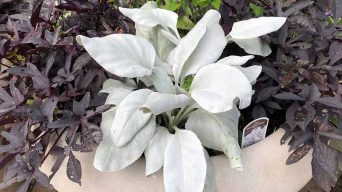Succulent plants like Senecio kleiniiformis can make a striking impression as a porch or patio plant in warmer climates, and they do well as houseplants in cooler climates.
Like many succulents, the Senecio kleiniiformis is easy to take care of and propagate as long as you provide for its basic needs.
However, not everyone knows how to take care of them so they can stay healthy and happy.
This guide will teach you everything you need to know about Senecio kleiniiformis care and propagation!
Overview
Senecio kleiniiformis, commonly called the Spear Head succulent, is a slow-growing plant that belongs to the genus Senecio and the family Asteraceae.
Native of South African, the Senecio kleiniiformis succulent species produces green-blue leaves and yellow flowers in branched clusters.
A typical Spear Head succulent plant can grow up to 12 inches in height.
The Senecio kleiniiformis is commonly known as:
- Spear Head
- Spear Head Senecio
- Reindeer Antlers
How To Care for Senecio Kleiniiformis (Spear Head)
Senecio kleiniiformis care is not difficult, but there are a few things that you need to be mindful of.
Sun Exposure & Light Requirements
The Senecio kleiniiformis succulent plant prefers partial shade rather than full sun.
Too much sun exposure will cause Senecio succulents to become too dry and may damage their leaves.
Plant the Senecio kleiniiformis in an area with a lot of indirect sunlight or light shade, if possible. Senecio plants shouldn’t be exposed to direct afternoon sun.
The Senecio kleiniiformis plant will need at least six hours of light each day.
It’s important to note that Senecios grow best when exposed to natural sunlight. This can provide the most significant amount of lighting and energy for them.
If you want your succulent garden outdoors, try placing it in a spot where buildings or trees won’t shade it during the afternoon sun.
If possible, place it near an eastern-facing window with morning/afternoon shade exposure when there is no direct exposure on Senecios from about noon until sunset.
Keep in mind that if Senecio plants don’t receive enough light, they’ll become weak and less likely to produce spiky leaves.
Watering Requirements
The Senecio kleiniiformis does not require a lot of water to thrive.
The Senecio kleiniiformis should be watered every two weeks during the warmer months. They can go up to three weeks during cooler temperatures.
Allow soil to dry out between watering, and never let Senecio kleiniiformis sit in water.
The Senecio kleiniiformis requires light watering from time to time to provide nutrients.
Still, too much water will cause rot and even kill Senecios if they are overwatered for long periods.
To prevent this, pour just enough water in their pot so that there are a few inches below where you’re pouring on – make sure not to drown them with excess moisture!
Soil Requirements
Senecio kleiniiformis, like most succulents and cacti, need a soil that drains well.
The best potting mixture to use is a well-draining cactus potting mix mixed with coarse sand.
The sand can aid in preventing root rot, which might otherwise lead to the demise of the roots and result in the yellowing of the leaves on your succulent plant.
The potting mix should have at least one-third of coarse sand.
The soil mixture must be slightly amended with some organic matter, such as compost or rotted leaves. These will provide the Senecio kleiniiformis with additional nutrients.
Most people mix their own potting by combining equal parts of rich soil, sand, and compost or rotted leaves.
Temperature and Humidity
The Senecio kleiniiformis is native to habitats with dry climates, so it will thrive in areas that receive less than 12 inches of rain annually.
The succulent plant can tolerate temperatures between 50°F and 85°F without any problems.
Since Senecio kleiniiformis prefers dry climates, the humidity should be kept at 50% or below.
Additionally, since it can tolerate a wide range of temperatures without any problems, Senecio kleiniiformis does not need to be positioned near heat sources such as fireplaces and radiators.
If you choose to use an artificial light source for your Senecio plant, make sure that it is within two inches from the topmost leaves of the plant.
Keep in mind that Senecios do not like direct sunlight. Still, they can grow under those conditions with no adverse effects.
Fertilizing
Fertilizing Senecio kleiniiformis can start from a very early age.
When the plant is only four months old, it should be watered with diluted fertilizers and nutrients every two weeks.
As soon as the Senecio kleiniiformis reaches six months of age, it can be fertilized more often using standard water quality or commercial nutrient solutions specifically designed for succulents.
The Senecio kleiniiformis will need to receive fertilizer about three times a year to maintain good health throughout their lifetime.
It is important not to overfeed them because this may lead to browning leaves which could signal nitrogen toxicity if left untreated for too long!
Potting and Repotting
Potting a Senecio kleiniiformis is not difficult, but you need to do it about every year.
The Senecio kleiniiformis requires more frequent repotting than most other houseplants because their growing points are on the surface of their roots, making them susceptible to rot when overwatered.
If you want your succulent to grow faster or larger than it would in its original pot size, repotting is an excellent way to make this happen.
Potting
To prepare the container for planting your Senecio kleiniiformis, thoroughly water it until moist all over, then let it drain completely before adding soil.
Fill the container with your chosen potting mix, then set the Senecio on top of it and cover all around to leave one inch of space between the surface and plant tops.
You want enough room for roots to grow without being crowded or smothered by dirt.
First Watering
Some plants might not need full watering because they are in terra cotta pots that hold moisture well or have been freshly watered before planting.
Others may need more water right away so their root system can take root faster.
The best way to tell is by feeling how moist the soil feels below Senecio’s leaves. If you don’t feel any dampness, water thoroughly until Senecio’s leaves are again moist.
Repotting
To repot Senecio kleiniiformis, remove the plant from its container by loosening and gently pulling apart roots that have grown around the edges of the pot.
Then turn Senecio upside-down to see where it has made contact with soil.
If Senecio is a little crowded for space in an existing container, use your fingers or a blunt object to make more room for root growth before planting Senecio into a new pot.
Fill the newly selected planter halfway with dirt, then place your plant on top again, so there is one inch of space between the surface and plant tops.
Continue filling the rest of the pot with potting mix until the Senecio is fully planted and the top of its root system reaches the surface.
Pot Size
It’s important to select a pot size appropriate for Senecio kleiniiformis because it will affect how much water it needs and how quickly it can be repotted when necessary.
Larger plants might require a 24″ or even larger in diameter container, while smaller plants need as little as an eight-inch planter.
The most common soil types are cacti/succulent mix, sand mixed with compost, perlite, and vermiculite.
Whatever you choose should have good drainage, so Senecio does not rot from lack of oxygen on roots due to too wet soil.
Pruning
Pruning Senecio kleiniiformis helps to shape the plant and grow new branches.
You can do this by removing any dead or dying leaves from around the base of the plant.
Then, using a sharp blade (a knife works well), slice off some stems which are too long for the plant to support.
This will encourage the Senecio kleiniiformis to grow new branches with healthy leaves at its base.
Pests and Diseases
Pests and diseases can be a common problem with even the hardiest succulents.
The Senecio kleiniiformis is not exempt, but there are things that you can do to prevent them from happening in your garden.
First of all, don’t overwater; when plants get too much water, they become more susceptible to pests and disease.
Another easy way to help avoid these problems is by regularly inspecting plants for any areas where leaves may have fallen off or been chewed up. This could indicate an infestation or some other pest issue like mealybugs or aphids.
You should also look out for bugs such as spider mites, which often come along in large numbers if another pest has already compromised the plant.
How to Care for Senecio Kleiniiformis (Spear Head) in Winter
Senecio kleiniiformis winter care is not difficult, but it requires some knowledge of their preferred conditions.
It is important to note that Senecio kleiniiformis is a much more cold-tolerant succulent plant than most others, so this care advice will be slightly different for Senecio plants with lower tolerance.
The first thing you need to do when caring for Senecio in winter is make sure there’s no residual water left on the leaves or stems from watering or misting them.
If there is any moisture present, remove it with a paper towel before going indoors or bring them inside if you’re already outside (if frost has been forecast).
Frost can cause leaf burn and breakage, which could lead to death if left unchecked.
When taking Senecio Senecio kleiniiformis inside for the winter, they will need to be given bright light.
For Senecios that are not typically grown indoors, it is often best to leave them outdoors where they can get some natural sunlight instead of relying on artificial indoor lighting.
If you have Senecios in a frost-prone area or if temperatures drop below 22°F (-12°C) at night, plan to bring them in before cold weather and keep them warm (above 50°F/14°C).
A good rule of thumb for cold-hardy succulents is to bring them in when nighttime temperatures are below 30°F (0°C).
How To Propagate Senecio Kleiniiformis (Spear Head) Succulents
Senecio kleiniiformis can be propagated by seeds and by cuttings.
Seeds
Senecio kleiniiformis seeds can be propagated by sowing them in well-drained soil.
This plant is not a heavy feeder, so it doesn’t need to be fertilized. Keep the soil moist and provide light for the germination of seeds (direct sunlight preferred).
Cuttings
Take cuttings from Senecio kleiniiformis in the spring.
Cut off a branch with about four or five leaves, and remove all but one leaf (leave a single-leaf cutting).
Allow it to callous for a few days before placing it in soil. Keep well watered until rooted.
This plant can take time to root, so don’t give up! Try again if you are unsuccessful at rooting your Senecio kleiniiformis succulent.
Is the Senecio Kleiniiformis (Spear Head) Toxic?
The Senecio kleiniiformis plant can be toxic to humans and animals.
The Senecio kleiniiformis plant is not likely to be toxic if eaten in small quantities or as part of your regular diet. However, it can cause vomiting and stomach pains when ingested in large doses.
It’s essential to take precautionary steps like keeping the Senecio kleiniiformis away from children and pets that might want to eat. They are more susceptible to becoming ill after eating this succulent plant than an adult would be.
Final Thoughts
In conclusion, the Senecio kleiniiformis is a beautiful succulent plant that is easy to maintain and propagate, making it the perfect houseplant for beginners.
Although Spear Head succulents are great indoor plants, they can be grown outdoors with a bit of care and patience.
This type of Senecio succulent is particularly interesting because it can be grown in areas with partial to full shade.
So if you live somewhere that only gets small amounts of sun during the day, this plant might do well for you.

